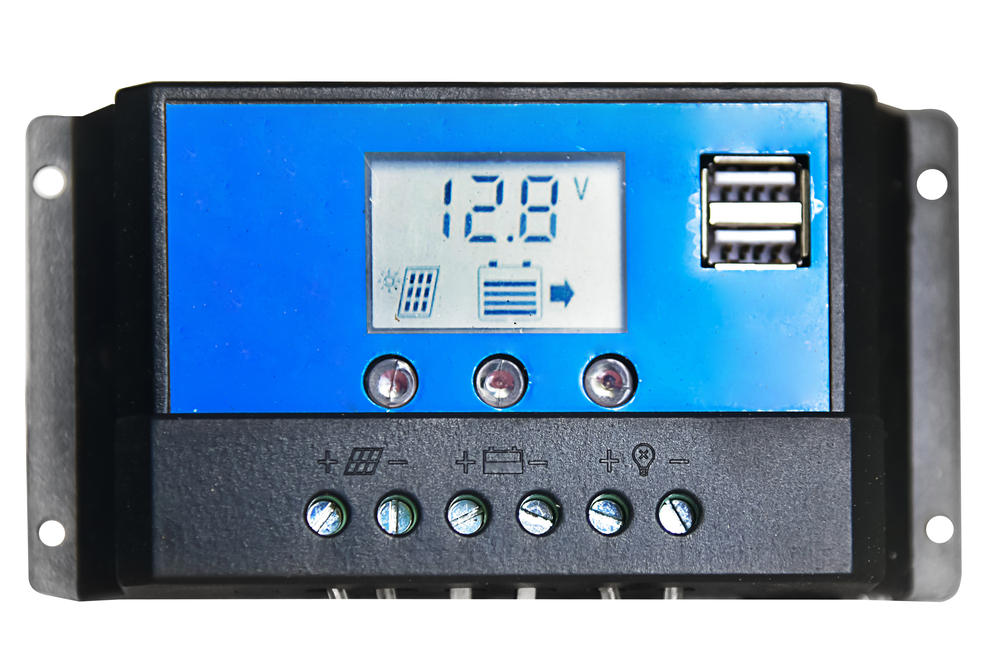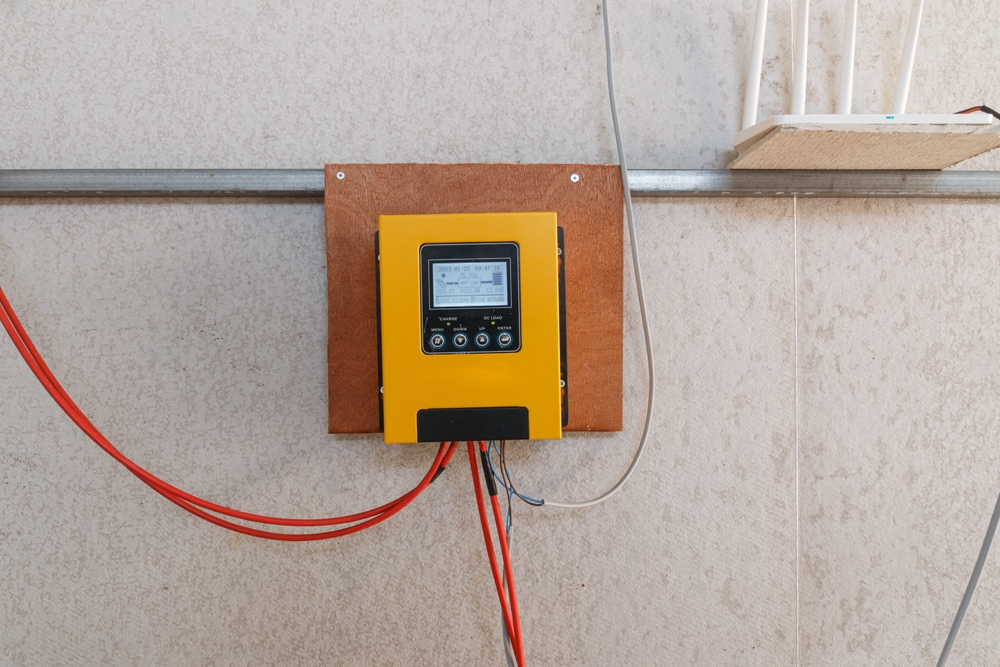
Buyer Guides
Solar Charge Controllers: What You Need to Know
Optivolt
May 18, 2023
6 min read
The basic components of a solar power system are easy to understand: solar panels generate electricity, and a battery bank stores the power. But what if the panels produce more power than the batteries can handle? And what if the current accidentally flows from the battery back to the panels? This is where solar charge controllers come into play.
Solar charge controllers are an integral part of any solar power system. In this article, we will learn about the different types of solar charge controllers and how they regulate the power generated by a solar array.
What is a Solar Charge Controller?
A solar charge controller — also known as a voltage regulator — is a component found in most residential and RV solar power systems. These devices regulate the flow of electricity from the solar panels to the battery bank or other loads. They are meant to prevent over-charging or discharging the solar batteries, providing an aspect of safety to the system.
Solar panels generate electricity in an unregulated manner. The voltage and current that they produce are variable and always changing with the available sunlight and other conditions.
Solar batteries don't work well with the varying output of a solar array. Instead, they require specific voltages and currents to charge properly without suffering damage. A solar charge controller acts as a mediator between the two system components, conditioning the produced power to match the battery's requirements.
Key Functions of a Charge Controller
Solar charge controllers perform a few functions that provide safety and power regulation to your system:
- Battery Protection: The lifespan and capacity of a battery can be harmed by excessive discharging. Safety issues can occur if the battery continues to receive a charge even if it is full. Solar charge controllers implement overvoltage protection and low voltage disconnect to protect your batteries from damage.
- Charge Regulation: The controller monitors the voltage and current coming from the panels. The power is regulated and conditioned for battery compatibility.
- Load Control: Some controllers include load terminals to directly connect DC lights or other devices. This can be useful for basic systems, eliminating the need for an inverter or excessive wiring and setup for a small DC load.
- Display and System Monitoring: Most solar charge controllers incorporate a display and monitoring system. This allows the user to view battery voltage, charging rates, and other system vitals.
Solar Charge Controllers: MPPT vs. PWM
There are two main types of solar charge controllers: Maximum Power Point Tracking (MPPT) and Pulse Width Modulation (PWM).
MPPT Solar Charge Controllers
MPPT controllers operate by continuously searching for the voltage at which the highest power output can be drawn from a string of solar panels. This is referred to as the "maximum power point."
Without MPPT, charge controllers don’t track the “maximum power point” and simply resort to a default voltage setting. Non-MPPT controllers lose out on a lot of available energy during higher- or lower-than-typical lighting conditions such as: morning, evening, cloud cover, cloud lensing, reflection, shading and/or obstruction.. MPPT controllers operate at high efficiency in a wide range of conditions, often resulting in 15-25% additional energy daily with the same solar panels, on- or off-grid.
The energy-harvesting potential of MPPT is further increased when used in conjunction with shade-tolerant solar panels. These photovoltaic modules incorporate cutting-edge technology to improve the efficiency of partially-shaded solar panels. However, panels like these maintain a much narrower voltage range for their “maximum power point” across many conditions, compared to traditional panels, which vary much more strongly due to bypass diode effects. So, shade-tolerant solar panels also tend to work better with PWM controllers.
Portable power stations and solar generators are popular all-in-one solutions that combine all of the solar components (except for the panels) into one self-contained system. Most of these devices incorporate a built-in controller. If this is the case, adding a charge controller in between the panels and the portable power station would not be necessary.
PWM Solar Charge Controllers
PWM controllers are another popular type of charge controller. Put simply, they function by rapidly switching the solar panel output on and off to regulate the battery voltage while maintaining a constant solar voltage. They are a less-efficient alternative to MPPT controllers.
A PWM controller cannot modulate the voltage that solar panels deliver.This leads to a massive loss in efficiency and energy savings over time.

Charge Controller Sizing
The charge controller you choose needs to be able to handle the power that your panels will provide. An improperly sized charge controller can lead to safety issues or an efficiency loss. Make sure to check the input and output voltage and current ratings provided in the product specification or manual for any charge controller you are considering, and make sure you do not exceed these in your system. Keep in mind that a single charge controller may list multiple different current ratings which depend on solar array and/or battery voltage.
Charge controllers have a few different power ratings to look for, including:
- Maximum PV Input Power: This designates the maximum wattage of a compatible solar array. There may be different ratings for different voltages. For example, a controller rated for 500W @ 12V will also be compatible with a 1000W system @ 24V.
- Maximum PV Input Voltage: This is the maximum voltage of a solar array that the controller can accept.
- Rated Charge Current: This is the maximum current that the controller can work with, usually denoted in amps. This applies to both the power coming in (from the solar panels) and the power going out (to the battery bank). These two amperages may be different if your solar panel voltage is higher than your battery bank. The charge controller should have an added safety buffer of 25%.
- Maximum Battery Voltage: This is the maximum battery voltage that the controller can work with and supply a charge to. Remember that batteries operate at a higher voltage than their rating suggests — for instance, a 24V battery bank will operate between 28–32V depending on its current charge level.
Let's consider an example in which you have five Optivolt 100W High-Voltage Panels, each having a max current rating of 2.8A and a max voltage of 48V. If the eight panels are wired together in parallel, then the maximum voltage would remain the same (48V). The maximum amperage of the array can be calculated as follows:
5 Panels × 2.8A = 14A
So the array will have a maximum output of 14A and 48V. If we are using a 48V battery system, then we just need to add a safety buffer:
14A × 1.25 Safety Buffer = 17.5A
In this case, you would need a charge controller with these specifications:
Rated Charge Current: At least 17.5A Maximum PV Input Voltage: At least 48V Maximum PV Input Power: At least 500W
If your panel voltage and battery voltage do not match up, then you will need to perform one more calculation to find the minimum ‘rated charge current’ of your controller. If we are using a 24V battery system, then the current being sent to the batteries will double (due to the voltage being cut in half):
17.5A × 48V = 35A × 24V
So if you were attempting to use a 24V battery bank with the above 500W solar array, you would need a charge controller with a rated charge current of at least 35A.
Also be sure that the controller is compatible with your battery bank, including the battery type, chemistry, voltage, and wire gauge.
Which Solar Charge Controller is Right For Me?
Although they may cost less upfront, PWM controllers will produce much less power over the lifetime of a system. If efficiency is not a concern and you are just powering a few lights or a pond, then PWM controllers may serve as a cost-effective alternative to MPPT.
For residential, RV, and similar high-powered systems, MPPT is almost always the better choice. The increased energy generation will quickly make up for the higher initial purchase price.
Related Questions
Do I Always Need a Solar Charge Controller?
The vast majority of solar power systems require a charge controller in order to operate in a safe and efficient manner. Outside of certain applications, small systems that utilize trickle-charge panels (10 watts or less) should not require a charge controller. Residential and RV solar systems usually need a charge controller. If you are using a solar generator or portable power station, it should have a built-in charge controller.
